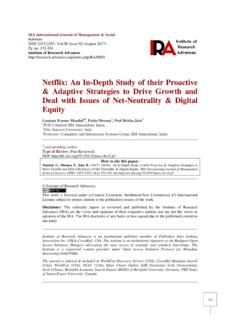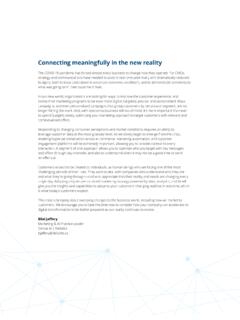Transcription of 4 Segmentation, targeting and positioning
1 74 Last A Head on SpreadSegmentation, targeting and positioningObjectivesAfter reading this chapter you should be able to: describe the main methods of segmenting markets; explain how segmentation aids profitability; decide whether a given segment is sufficiently profitable to be worthtargeting; explain the purpose of segmentation ; develop ways of assessing the economic viability of segments; explain the growth of segmented markets; establish strategies for dealing with segmented markets; describe perceptual mapping; describe the main issues surrounding the positioning of for segmenting marketsINTRODUCTIONThe segmentation concept was first developed by Smith in 1957,1and is con-cerned with grouping consumers in terms of their needs. The aim ofsegmentation is to identify a group of people who have a need or needs that canbe met by a single product, in order to concentrate the marketing firm s effortsmost effectively and economically. For example, if a manufacturer produces astandardised product by a mass-production method, the firm would need to besure that there are sufficient people with a need for the product to make the exer-cise assumptions underlying segmentation are: Not all buyers are alike.
2 Sub-groups of people with similar behaviour, backgrounds, values and needscan be identified. The sub-groups will be smaller and more homogeneous than the market as awhole. It is easier to satisfy a small group of similar customers than to try to satisfylarge groups of dissimilar is concerned with choosing which segments to aim for. Segmentationis essentially about dividing up the market ; targeting is about the practicalities ofdoing business within the market . The two are clearly closely linked, since thesegmentation process will usually provide information as to which segments arelikely to prove most profitable, or will help the firm achieve its strategic objec-tives in other is concerned with the brand s relationship with other brandsaimed at the same segment. positioning is about the place the brand occupies inthe minds of the consumers, relative to other FOR SEGMENTING MARKETSEach consumer is an individual with individual needs and wants. On the face ofit, this creates a major problem for the marketer, since it would clearly be impossi-ble to tailor-make or customise each product to the exact requirements of the Industrial Revolution most products were individually made.
3 Thisproved to be expensive, and essentially inefficient once mass-production tech-niques had come into being. Unfortunately, mass-production (taken to theextreme) means a reduction in the available choice of product, since the best wayto keep production costs low is to have long production runs, which means stan-dardising the product. Every adaptation costs money in terms of re-tooling andre-packaging the product. In some economies, particularly those in parts ofEastern Europe and in the Third World, there is not sufficient wealth or invest-ment in industry to allow for the production of many different types of economies still rely heavily on mass production, and mass marketing (or undifferentiated marketing) in which a standard product isproduced for all consumers will only be effective if the consumers concernedhave little choice and do not already own a product that meets the main example, in 1930s Germany few families owned cars. Hitler promised theGerman people that every family would own a car, so Porsche was commissionedto develop the Volkswagen (literally people s car ) as a basic vehicle, whichcould be cheaply produced for the mass approach is less effective in economies where most consumers alreadyown the core benefitsof the product.
4 Once car ownership was widespread andthe core benefit of personal transportation was owned by most families, con-sumers demanded choices in features and design of their vehicles. Segmentationdeals with finding out how many people are likely to want each benefit, roughlyhow much they will be willing to pay for it, and where they would like to buy itfrom. In this way, the firm approaching a segmented market is able to offer morefunctional benefits and more attention to hedonic needs, the products are morefun (see Chapter 3).In order to make these adaptations worthwhile, marketers need to be reason-ably sure that there is a large enough market for the product to be viableeconomically. On the other hand, concentrating on a smaller segment means thateconomies can be made in the supplier s communications activities; rather thanadvertise to a mass market , for example, the marketer would be better off concen-trating resources on producing an advert that is tailored to the target segment an ad, in other words, designed for the ideal customer and no reason for this is that consumers are surrounded by advertising consumers learn to avoid advertisements, and particularly to avoidones that are clearly never going to be of any interest.
5 At the same time, con-sumers will go out of their way to find out about products they have someinterest in, often by reading special-interest magazines. Therefore an advertise-ment that is tailored to a specific group of consumers, and that appears in amedium that those consumers use, is likely to be far more effective than an untar-geted advertisement in a general-interest that aim for small segments usually have much greater credibilitywith consumers, and can learn to provide exactly what most pleases , the main purpose of segmenting is to enable the company to concen-trate its efforts on pleasing one group of people with similar needs, rather thantrying to please everybody and probably ending up pleasing nobody. Table the advantages of segmenting the 4 segmentation , targeting and positioningSEGMENTATION VARIABLESA segment must fulfil the following requirements if it is to be successfullyexploited: It must be measurable, or definable. In other words, there must be some way of identi-fying the members of the segment and knowing how many of them there are.
6 It must be accessible. This means it must be possible to communicate with thesegment as a group, and to get the product to them as a group. It must be substantial, big enough to be worth aiming for. It must be congruent, that is to say the members must have a close agreement ontheir needs. It must be stable. The nature and membership of the segment must be reason-ably three key criteria are accessibility, substance and measurability,3but it isimportant also to look at the causes underlying the enablesthe marketer to anticipate changes more easily and sometimes to verify that thesegmentation base is correctly variablesAdvantage Explanation Customer analysisBy segmenting, the firm can get to understand its best customers better. Competitor analysisIt is much easier to recognise and combat competition when concentrating on onesmall part of the overall market . Effective resource Companies scarce resources can be concentrated more effectively on a fewallocationconsumers, rather than spread thinly across the masses.
7 Strategic marketing Planning becomes easier once the firm has a clear picture of its best the marketGood segmentation can increase the overall size of the market by bringing in newcustomers who fit the profile of the typical customer, but were previously unawareof the product. TABLE of segmentationThere are many bases for segmenting, but the following are the main ones: Geographic. Where the consumers live, the climate, the topology, etc. For exam-ple, cars in California almost always have air-conditioning; cars in Swedenhave headlights that stay on constantly because of the poor quality of the lightfor much of the year. Geographic segmentation is very commonly used ininternational marketing, but is equally useful within single nations. Psychographic. Based on the personality type of the individuals in the example, the home insurance market might segment into those who areafraid of crime, those who are afraid of natural disasters, and those whoare afraid of accidental damage to their property.
8 Behavioural. This approach examines the benefits, usage situation, extent of useand loyalty. For example, the car market might segment into business usersand private users. The private market might segment further to encompassthose who use their cars primarily for commuting, those who use their cars forhobbies such as surfing or camping, and those who use the car for domesticduties such as shopping or taking children to school. The business marketmight segment into prestige users such as managing directors and seniorstaff, or high-mileage users such as salespeople. Demographic. Concerned with the structure of the population in terms of ages,lifestyles, economic factors. For example, the housing market can be dividedinto first-time buyers, families with children, older retired people, and elderlypeople in sheltered accommodation; equally, the market could be segmentedaccording to lifestyle, with some accommodation appealing to young profes-sionals, some appealing to country-lovers, and so segmentationGeographic segmentationmay be carried out for a number of reasons.
9 The nature of the product may be such that it applies only to people livingwithin a specific area, or type of area. Clothing manufacturers know that theywill sell more heavy-weather clothing in cold coastal areas than in warminland areas. If the company s resources are limited, the firm may start out in a small areaand later roll out the product nationally. It might be that the product itself does not travel well. This is true of sheetglass, wedding cakes and most personal services such as may be segmented geographically according to the type of housing inthe area. Firms that supply products specifically aimed at elderly people may78 Chapter 4 segmentation , targeting and positioningwish to locate (or at least concentrate their marketing efforts) in retirement aimed at young people might be heavily marketed in university towns,and so segmentationPsychographic segmentationclassifies consumers according to their personali-ties. As the reliability of measures has improved, more evidence has come to lightof links between personality and consumer behaviour,5but psychographic seg-mentation remains problematical because of the difficulties of measuringconsumers psychological traits on a large scale.
10 This type of segmentation there-fore often fails on the grounds of accessibility. For example, researchers mightfind out that there is a group of people who relate the brand of coffee that theybuy to their self-esteem. The problem then is that there is no obvious medium inwhich to advertise this feature of the coffee: if there were a magazine called CoffeeMakes Me Feel Good Monthlythere would be no problem. The advertisers aretherefore left with the mass media, such as TV advertising, which may be far tooexpensive for the purpose. Some of the most creative ideas in marketing haverevolved around ways of gaining access to such segmentationBehavioural segmentationcan be a useful and reliable way of segmenting. At itsmost obvious, if the firm is marketing to anglers they are not interested in howold the anglers are, what their views are on strong drink, or where they live. Allthe firm cares about is that they go fishing, and might therefore be customers fora new type of rod. Accessing the segment would be easily undertaken by adver-tising in the angling magazines.



